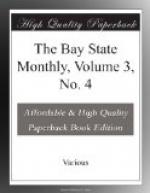Returning from the cemetery to the square, we still follow the British down the Boston road and pass at the corner near the church another building from which stores were taken and on the left houses of historical fame, the house and shop of Captain Brown who led the second company in the fight, the home of the patriot Lee and John Beatton who left funds for church purposes. Below this house which is two hundred years old, a guard was posted on the day of the fight and before it stand two elms so old that they are filled with bricks inside, and mended outside with plaster in order to preserve them. The next house on the right is the home of Emerson, a plain wooden building with trees near the western side, and a fine old-fashioned garden in the rear. His study was in the front of the house at the right of the entrance. One side is filled to the ceiling with books, and a picture of the Fates hangs above the grate, a table occupies the centre, at the right of which is the rocking chair in which he often sat, and his writing implements lie near on the table. From the study two doors lead to the long parlor with its large fire-place around which so many noted people have gathered.
After passing the home of Emerson the road turns toward the left and leads past the farm and greenhouses of John B. Morse, the agricultural author, to the School of Philosophy which has just completed its seventh session with success, the attendance having steadily improved certainly as far as culture is considered. It stands in the grounds of the Orchard House now the home of Dr. Harris who has carried out the idea of Mr. Alcott of whom he bought the place, by laying out beautiful walks over the crest of the wooded hill. He has surrounded a tall pine on the hill top with a strong staircase by which it can easily be climbed to a height of 54 feet from the base and 110 feet from the road in front of the school building or chapel. Orchard House was for years the home of the Alcott family where Louisa wrote and May painted and their father studied philosophy. A broken rustic fence one of the last traces of Mr. Alcott’s mechanical skill forms the slight barrier between the grounds at the Orchard House and Wayside, which Mr. Alcott bought in 1845 and a few years later sold to Nathaniel Hawthorne who owned it at the time of his death. The house is a strange mixture of the old and new, as the rear part bears evident traces of antiquity, at the right were the Hawthorne parlors and reception rooms, at the left of the entry his library, sometimes called the den, and in front a small room with a low window separates the dining room from the reception room and the whole is crowned with a tower built by Mr. Hawthorne for a study where he found the quiet and seclusion which he loved. Much of Mr. Hawthorne’s composition seems to have been done as he wandered up and down the shady paths which wind in every direction along the terraced hillside, and a small crooked path




